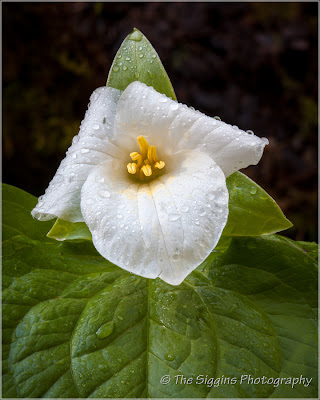All photos can be viewed large size by clicking on them. The Smoky Mountain photos are available for purchase here.
Kind of a strange title for a blog post. What in the world is he talking about? Photography that's not good? Ideas that are all wet? Developing film? Are you interested yet?
I'm talking about what I did this last weekend. The forecast was for up to 2 inches of rain in the Great Smoky Mountains National Park Saturday and Sunday with locally heavy down pours and possible lightning. Sound like a good time to stay in doors and wait for better weather right? No way! Time to grab the camera and head to the mountains!
There have been times when I've been out taking pictures on a bright sunny cloudless day and people I meet will say something like "What a great day to be out taking pictures. It's it beautiful?" I'll smile and say something like "It sure is a beautiful day" but in my mind I'm wishing for clouds and even a little rain. You might be thinking my head should be examined.
Bright sunny days are not great conditions to take landscape photos, especially during the hours between an hour after sunrise and an hour before sunset. At these times the light can make taking photos very difficult. The bright sunlight can make parts of a scene extremely bright while other parts are in deep dark shadows. Under these high contrast conditions it is hard to find an exposure that works for both the bright and dark areas. Expose for the bright spots and the shadows are very dark without any details. Expose for the shadows and the bright parts are over exposed, sometimes to the point of being solid white with no details. HDR photography can be used to overcome these conditions but even with HDR techniques it can be difficult to get to a realistic photo that is pleasing to look at.
Stormy days are the opposite. If the entire scene is in the shadow of clouds then the difference between the brightest and darkest areas of a photo are not as extreme. You can more easily come up with a single exposure that covers the entire range of light in the scene. Gone are the dark shadows and blown out bright highlights. Partly cloudy may not work if you are still dealing with bright sunny and cloudy spots in a scene. You need a solid overcast day.
Rainy days are even better. When foliage is wet it can bring out the vibrant colors in the green leaves, brown soil, and colorful flowers. It's important to use a polarizing filter when there is any water on the subjects, even when it is dark and cloudy. A polarizer will cut the reflection off wet leaves and other surfaces and allow the dark rich colors to be captured, as in the photo below. It was really pouring when I took this one, but the 2 1/2 second exposure allowed me to blur the water and make the raindrops "disappear".
So, when the forecast was for a rainy weekend June and I made reservations at our favorite hotel in Townsend Tennessee and headed for the mountains. I am blessed to have a wife who is willing to go away on a weekend of wet rainy weather and drive around looking for that shot of a flowering dogwood hanging over the far bank of a rushing stream or the wildflower covered in rain drops.
These dark wet days are also the best time to take photos of streams and waterfalls. The low light conditions allow me to get slow exposures that create the silky white water effect that I really like. In the first photo above, I was able to get a long six second exposure making the water soft while keeping the rocks sharp and well defined.
Some of the best conditions can be at the end of a storm when the skies start to clear. If this occurs in the early morning or late afternoon God may put on a dramatic show of sunlight and storm clouds that can be breathtaking. I didn't get these conditions this weekend but there was a time when the rain stopped and the clouds started to lift. I took 8 vertical (portrait orientation) shots and stitched them together to create this wide panorama of Cades Cove. You can see the brilliant colors in the field and some of the fog hanging in the mountains.
There are some conditions where bright sunny days are good for landscape photos. In this example from Glacier National Park, the sunlight was behind me and evenly lit the field and mountains, without harsh light or dark shadows. The 6,600 foot altitude made the sky deep blue, which made the mountains stand out. This shot wouldn't have worked on a cloudy day.
Bottom line is don't let the weather keep you from going out, taking some photos, and enjoying God's creation. Figure out what works well under the conditions God has given you and shoot it.
Enjoy!









